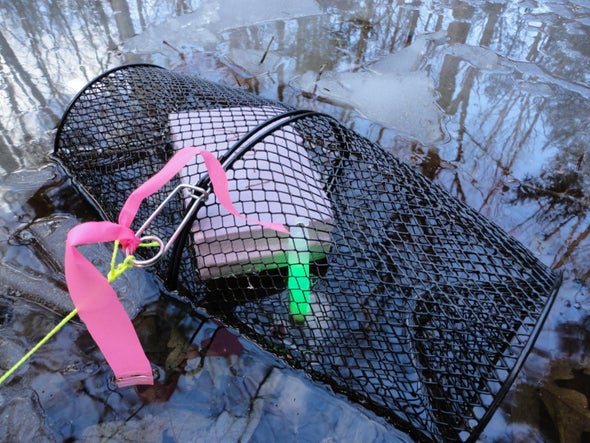What Animal Is Like A Glow Stick

Ecologists needed a way to more easily keep track of populations of amphibians, and green glow sticks lit the style.
Populations of frogs, salamanders and other amphibians are declining effectually the world—even in protected areas, similar U.S. national parks. Ecologists needed a unproblematic method to track the animals' numbers. Now, researchers have constitute an constructive way to proceed tabs on amphibians—using that concert and party favorite: glow sticks. Green glow sticks, to be specific.
"What we exercise know is that their eyes are particularly sensitive to green calorie-free."
David Munoz, a PhD candidate in the ecology program at Penn State University.
To exam the thought, Munoz and colleagues fix up minnow traps with and without glow sticks at a dozen vernal pools in Centre County, Pennsylvania. The critters gather at the pools to breed.
For a month, they trapped and tracked numbers of the Jefferson salamander, the spotted salamander, the woods frog and the eastern cherry-red-spotted newt. "Right before we left for the day, around 4 P.K., we'd activate the glow stick and hang information technology on the little minnow trap, come dorsum the next day to see what we got."
Traps with glow sticks were vastly more productive. "We were really surprised by how potent of an consequence our glow sticks had on our captures. So, by just putting a glow stick in one of these minnow traps we increased the capture rates for our spotted salamanders and our Jefferson salamanders between on average ii to iv times." And for the eastern ruby-red-spotted newt, the glow stick traps lured six times as many. [Michael Antonishak, David A. W. Miller and David J. Munoz, Using Glow Sticks to Increment Funnel Trap Capture Rates for Adult Vernal Pool Amphibians, in Herpetological Review]
"Yous know, these salamanders and these amphibians are going to these sites to breed. And so what are they looking for? They're looking for other individuals…and so what we remember is that the glow stick is either making the movement of other salamanders more credible, or it's potentially simply a simple visual cue…their eyes are sensitive to this type of light, so they might be attracted to it."
Regardless of the reason, Munoz hopes his squad's glowing discovery will benefit amphibians. "In lodge to help manage those species, and help bring them back, or reverse those declines, we need to understand what's causing those declines. And the style we exercise that is by monitoring populations."
Another nice thing most glow sticks: they're cheap. "Information technology gives scientists a new tool, and substantially a improve tool to help accomplish that monitoring on a cost effective basis."
—Annie Sneed
[The above text is a transcript of this podcast.]
Source: https://www.scientificamerican.com/podcast/episode/glow-sticks-help-ecologists-study-amphibians/
Posted by: kimafor1996.blogspot.com

0 Response to "What Animal Is Like A Glow Stick"
Post a Comment